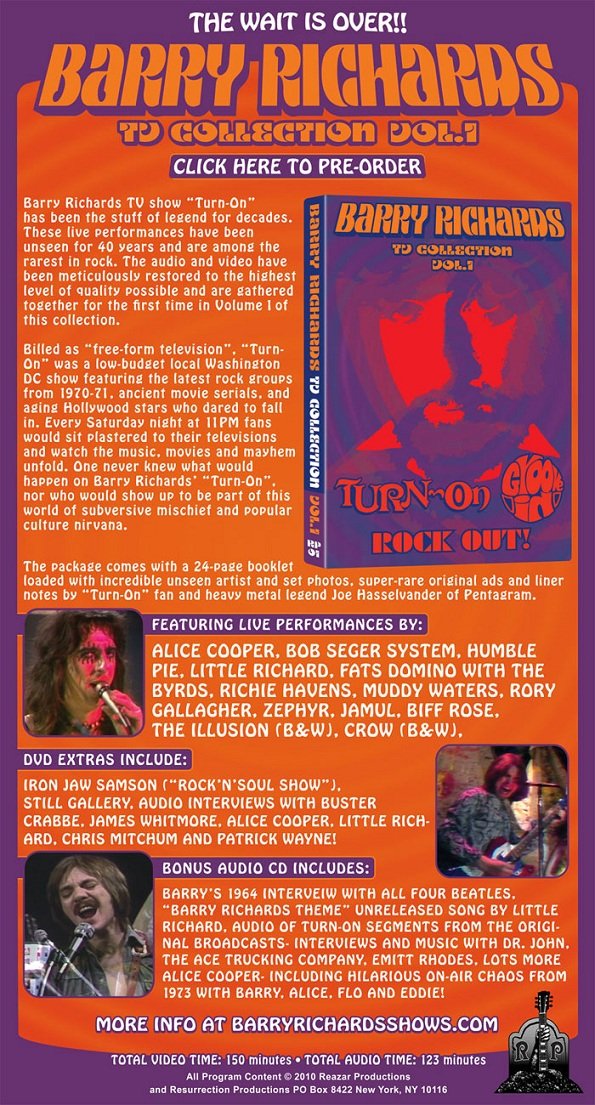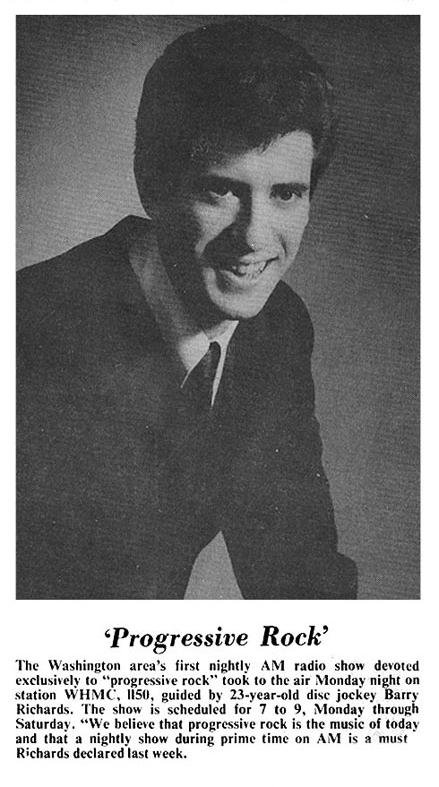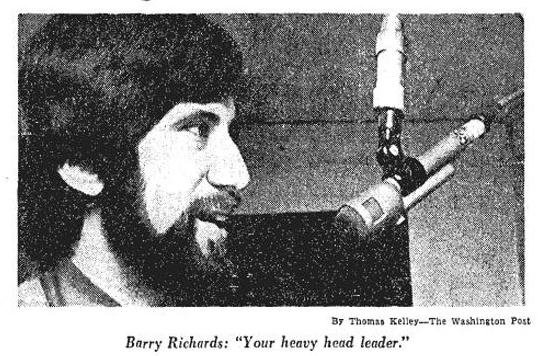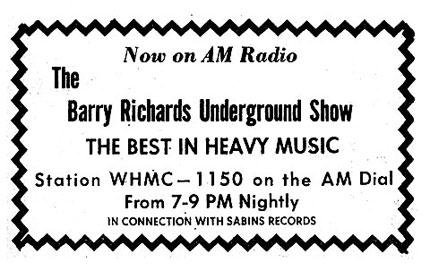BARRY RICHARDS T.V. COLLECTION, VOL. 1: And A Disc Jockey Shall Lead Them
It might sound strange but there was a time when a disc jockey was more than just a voice announcing the latest block of lame Top-40 programming. As the 1960's gave way to the 1970's, popular music was experiencing a revolution not unlike what Hollywood filmmaking was undergoing at that time: the frontiers of rock were being blown out in all directions by an array of ambitious musical acts and station owners began to experiment with progressive formats to tap into the newly-noticed underground audience that wanted to hear these diverse sounds.These progressive radio stations relied upon their deejays to discover the hip new acts and act as cultural ambassadors, indoctrinating the listeners into the wild, new lifestyle that rock music was breeding. Barry Richards was this kind of d.j.: he sought out daring new sounds for his radio audience, promoted concerts for these performers and even took advantage of late-night t.v. programming opportunities to bring the underground into the living rooms of young rock and roll fans. Barry Richards T.V. Collection Vol. 1 offers a generous cross-section of his work as a t.v. host. It's a fascinating time capsule of an era before media conglomerates had a stranglehold on the airwaves and you could actually interesting, locally-produced programming.The first segment is devoted to Groove In, an early programming attempt from 1968. This was before he went full-on progressive so it follows the lead of American Bandstand-type programming, complete with a panel of teenagers interviewing R&B singer Cliff Nobles (in a weird bit of irony, he had a fluke hit with "The Horse," an instrumental b-side from one of his songs, which he dances to Groove In in lieu of singing). The teen-centric segments are little corny, especially an unintentionally funny bit where a teen football player offers a monosyllabic film review for 2001: A Space Odyssey. That said, these segments offer an interesting view into the formats that Richards was up against when he started in television.From t
Barry Richards T.V. Collection Vol. 1 offers a generous cross-section of his work as a t.v. host. It's a fascinating time capsule of an era before media conglomerates had a stranglehold on the airwaves and you could actually interesting, locally-produced programming.The first segment is devoted to Groove In, an early programming attempt from 1968. This was before he went full-on progressive so it follows the lead of American Bandstand-type programming, complete with a panel of teenagers interviewing R&B singer Cliff Nobles (in a weird bit of irony, he had a fluke hit with "The Horse," an instrumental b-side from one of his songs, which he dances to Groove In in lieu of singing). The teen-centric segments are little corny, especially an unintentionally funny bit where a teen football player offers a monosyllabic film review for 2001: A Space Odyssey. That said, these segments offer an interesting view into the formats that Richards was up against when he started in television.From t here, the disc moves into an array of killer footage from Barry's late-night programming, featuring a variety of groups and singer performing live between 1970 and 1975. The majority of it comes from Turn On, the cult fave show that heartland rock fans best know him for. It kicks off with the pilot episode of the show, which features an eclectic array of talent: Little Richard appears alongside alternative comic Uncle Dirty and Zephyr, featuring a young Tommy Bolin on guitar, does a steamy version of "St. James Infirmary." Elsewhere, obscure psych/heavy rockers Jamul do a jam-happy version of "Tobacco Road" and back up Little Richard for a barnstorming take on "Good Golly Miss Molly."The next block of material culls various highlights from Turn On's 1970-1971 era. Alice Cooper kicks it off in high style with the Love It To Death lineup offering a nice grungy take of "Eighteen" that is followed by a full presentation of "Black Juju," complete with Alice brandishing a pitchfork and lounging in an electric chair. Other acts include Peter Frampton-era Humble Pie dishing up a fiery rendition of "Rollin' Stone" and a Van Dykes Park-esque set of piano pop tunes performed by Biff Rose (David Bowie covered one of his songs on Hunky Dory).
here, the disc moves into an array of killer footage from Barry's late-night programming, featuring a variety of groups and singer performing live between 1970 and 1975. The majority of it comes from Turn On, the cult fave show that heartland rock fans best know him for. It kicks off with the pilot episode of the show, which features an eclectic array of talent: Little Richard appears alongside alternative comic Uncle Dirty and Zephyr, featuring a young Tommy Bolin on guitar, does a steamy version of "St. James Infirmary." Elsewhere, obscure psych/heavy rockers Jamul do a jam-happy version of "Tobacco Road" and back up Little Richard for a barnstorming take on "Good Golly Miss Molly."The next block of material culls various highlights from Turn On's 1970-1971 era. Alice Cooper kicks it off in high style with the Love It To Death lineup offering a nice grungy take of "Eighteen" that is followed by a full presentation of "Black Juju," complete with Alice brandishing a pitchfork and lounging in an electric chair. Other acts include Peter Frampton-era Humble Pie dishing up a fiery rendition of "Rollin' Stone" and a Van Dykes Park-esque set of piano pop tunes performed by Biff Rose (David Bowie covered one of his songs on Hunky Dory). This middle block also features two downright revelatory sets. One come from Fats Domino, who is backed by the Byrds(!) as he performs a string of his classic hits. He looks oddly ageless as he cranks out his hits with a beaming smile and there's also a fascinating off-air bit where he coaches the Byrds through an arrangement of "Walkin' To New Orleans." The other killer is a three song set from the Bob Seger System, the band Seger had before becoming a heartland rock specialist. Seger is skinny and beardless her
This middle block also features two downright revelatory sets. One come from Fats Domino, who is backed by the Byrds(!) as he performs a string of his classic hits. He looks oddly ageless as he cranks out his hits with a beaming smile and there's also a fascinating off-air bit where he coaches the Byrds through an arrangement of "Walkin' To New Orleans." The other killer is a three song set from the Bob Seger System, the band Seger had before becoming a heartland rock specialist. Seger is skinny and beardless her e as he bares his teeth and howls his way through an electric set of garage rockers capped by his early classic "Ramblin' Gamblin Man."The next segment features some lost footage taken from grainy but watchable VHS dupe. These show off sets by the Illusion and Crow: the former is a sort of missing link between psych and hard rock while the latter delivers a heavy version of bluesy garage stylings (they had one chart hit with "Evil Woman," covered by Black Sabbath on their first album). It says a lot about Richards' enthusiasm for underground acts that he let such lesser-known performers do lengthy sets on his show.The final segments capture a few additional performances from the 1973-1975 era. Muddy Waters turns in a few blues classics, the best being a taut rendition of "Got My Mojo Working," and Irish blues-rocker Rory Gallagher delivering a sizzling rendition of "Walk On Hot Coals." The amusing closer to this set is footage of Iron Jaw Samson, an oddball nightclub performer who eats his way through a Pepsi can before chomping down on a lightbulb!
e as he bares his teeth and howls his way through an electric set of garage rockers capped by his early classic "Ramblin' Gamblin Man."The next segment features some lost footage taken from grainy but watchable VHS dupe. These show off sets by the Illusion and Crow: the former is a sort of missing link between psych and hard rock while the latter delivers a heavy version of bluesy garage stylings (they had one chart hit with "Evil Woman," covered by Black Sabbath on their first album). It says a lot about Richards' enthusiasm for underground acts that he let such lesser-known performers do lengthy sets on his show.The final segments capture a few additional performances from the 1973-1975 era. Muddy Waters turns in a few blues classics, the best being a taut rendition of "Got My Mojo Working," and Irish blues-rocker Rory Gallagher delivering a sizzling rendition of "Walk On Hot Coals." The amusing closer to this set is footage of Iron Jaw Samson, an oddball nightclub performer who eats his way through a Pepsi can before chomping down on a lightbulb! All in all, Barry Richards T.V. Collection Vol. 1 is a testament to the good work this d.j. did for budding rock fans, offering a strong mix of cutting-edge rockers, intriguing lesser known acts and respectful tributes to rock's pioneers. It also captures the go-for-broke spirit of local t.v. programming in the 1970's, displaying an ambitious, freewheeling love for alternative culture that television could use more of today.
All in all, Barry Richards T.V. Collection Vol. 1 is a testament to the good work this d.j. did for budding rock fans, offering a strong mix of cutting-edge rockers, intriguing lesser known acts and respectful tributes to rock's pioneers. It also captures the go-for-broke spirit of local t.v. programming in the 1970's, displaying an ambitious, freewheeling love for alternative culture that television could use more of today.


